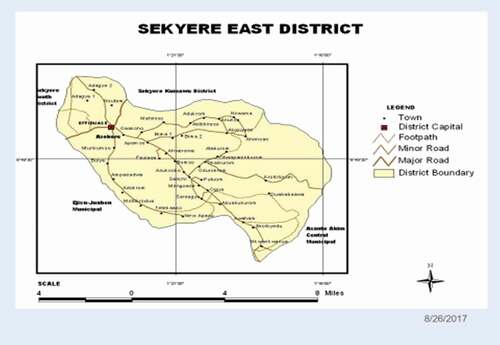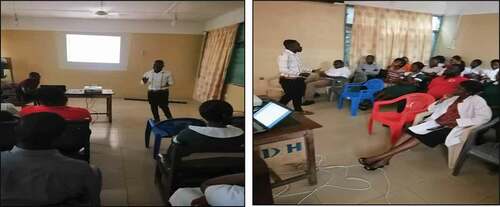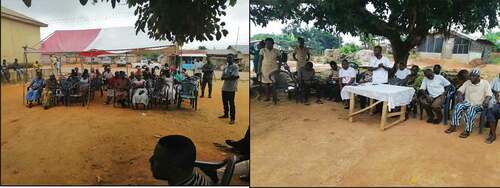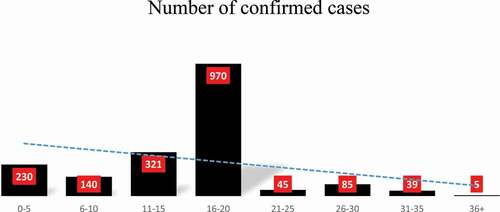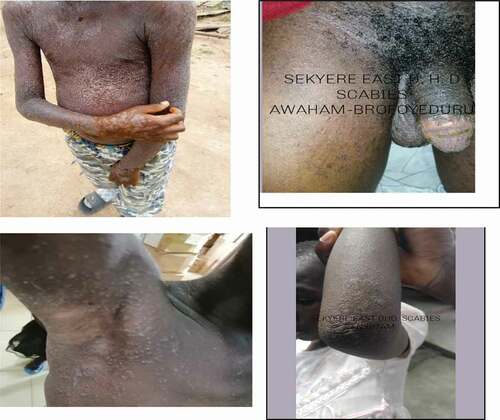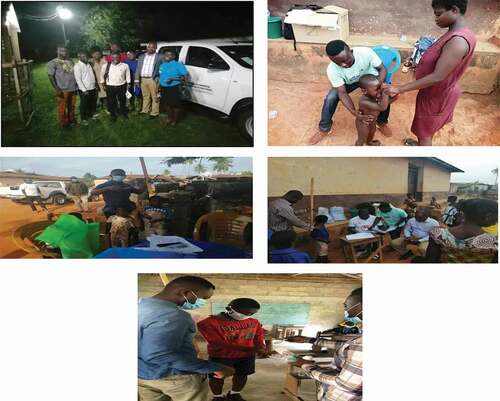Abstract
Abstract: Scabies is a Neglected Tropical Disease, transmitted from person to person contact and indirectly through fomites. Though preventable, the burden and infection rate of scabies remain a menace with inadequate attention given to it in Ghana. This report presents an outcome of active disease surveillance and response measures undertaken by the District Health Management Team on the fight against the spread of scabies through case search, treatment, awareness creation, and advocacy campaigns. Students and teachers from 29 schools within the Sub District and 21,173 people in 8 communities were targeted for screening and treatment. In all, a mass drug administration was carried on 2,575 students and teachers, and 2,467 infected patients representing 11.58% from the 8 communities were treated using ivermectin 15% and 25% benzyl benzoate emulsion and Sulphur ointment. Response to the outbreak was hampered by inadequate resources and personnel resulting in low geographical and treatment coverage. Also, intensifying public education and health staff capacity building on case search and control is needed and therefore, the District Health Management Team calls for support from stakeholders in managing the situation.
PUBLIC INTEREST STATEMENT
There is an outbreak of Scabies in the Sekyere East District of Ashanti Region, Ghana West Africa. Currently, the District has recorded about one thousand eight hundred and thirty-four reported cases (1,834) with no death. The Diagnosis was made using the International Alliance for control of Scabies (IACS) Diagnosis tool with a support of a dermatologist and Infectious Disease Clinician from Kumasi Centre for Collaborative Research and Tropical Medicine (KCCR).We have since responded to the outbreak but are unable to contain the situation as a result of inadequate resources, we estimate that about six thousand (6,000) people might have been infected by the disease at the time of this report, a call to end the spread is therefore crucial.
1. Introduction
Scabies is an ectoparasitic infection caused by the mite Sarcoptes scabiei and spread by person to person contact. It presents various abnormal skin lesions (nodules, pustules, papules, and occasionally urticarial) (Chouela et al., Citation2002; Moberg et al., Citation1984), with common manifestation being itching around the infected area. Scabies is considered one of the Neglected Tropical Diseases (NTDs), highly prevalent in developing countries with the most vulnerable being children and the elderly in resource-poor communities (Badiaga et al., Citation2005).
Globally, the prevalence rate of scabies infections varies between 0.3 and 46%, with an estimated yearly reported case occurring around 300 million people (Chosidow, Citation2006). In Turkey, a retrospective study by Baykal et al. (Citation2021) revealed a doubling rate of scabies infection from the fourth quartile of 2018 to that of 2019 as compared to the same period in 2016 to 2017. Notably, the infection rate is high and on the rise in Asian, European, and African countries (Baykal et al., Citation2021). The case of Africa is particularly worrying. For instance, a nationwide prevalence rate of about 9.7% with as high as 39.2% in some zones in Ethiopia was recorded in 2018. In Ghana, though the nationwide prevalence rate is unknown, a retrospective review of skin diseases in Korle Bu Teaching Hospital revealed a 5.1% reported cases. As noted by Engelman et al. (Citation2019) and Thean et al. (Citation2019), the reason for the lack of data or underreported cases of scabies in developing countries and resource-poor communities is largely due to challenges in diagnoses and stigmatization.
NTDs, aside from their health implications, have a huge socio-economic burden on the nation and the world at large. The acute pain and secondary complications associated with scabies adversely affect sleep, work, and the quality of life (Jackson et al., Citation2007). Also, excoriations from scratches expose the skin to secondary bacterial infections that result in cellulitis, impetigo, and pyoderma. Globally, an estimated 660,000 incidents of secondary bacterial infections are reported annually among scabies patients, with about 24.2% case fatality rate per year (Carapetis et al., Citation2005). This outcome imposes a severe socioeconomic burden on the affected persons, their immediate family, communities, and health care systems. Also, the incidence of scabies could result in poor performance of school children (Kaburi et al., Citation2019) and widespread underdevelopment in the world’s poorest regions where water safety, sanitation, and access to health care are substandard.
NTDs are called “neglected” because they have been generally wiped out in the more developed part of the world but persist in the poorest, most marginalized, or isolated communities. Though preventable, the infection rate and burden of the disease remain a social menace with less or no priority attached to it compared to other diseases. For instance, a recent five-year Master plan for neglected tropical diseases programme, ghana (Citation2016–2020) for reducing NTDs and its related burden in Ghana excluded scabies though its prevalence was widespread. Therefore, there is the need to create awareness and advocacy campaigns in the fight against the spread of NTDs and scabies in particular.
In the quest to mitigate the widespread of NTDs, management of the Sekyere East District health directorate consciously embarked on an intensified integrated disease surveillance and response measures. The latest development from reported cases emanating from the various communities depicts an alarming incidence of scabies among other cases of NTDs. Therefore, this report seeks to depict the current situation of the case in the district, surveillance and response measures adopted by health management as well as provide an early call for an effective and efficient intervention to mitigate the complications, complexities, and associated socio-economic consequences in the district. shows the map of Sekyere East District.
2. Case representation
2.1. Public health action and methods
Following the widely reported cases of scabies across health centers in the Sekyere East District, the District Health Management Team (DHMT) embarked on intensified integrated disease surveillance and response measures. The team sought to conduct an environmental assessment of the various schools and communities involved, establish any epidemiological link between the cases, and sensitize clinicians on case identification and treatment while instituting remedial actions to control the outbreak and prevent future occurrences.
A stakeholder consultation meeting was held on 7 October 2019 to orient the team on the program’s organization and execution plan for further action. The meeting was to enlighten members on the disease and also to help them understand the need for a case search in the various communities. A surveillance team of five members was formed by the DHMT and was joined by the Disease Control Officer with his/her Community-Based Surveillance volunteer in each community visited.
As part of the effort to get everyone who matters involved, the district assembly was debriefed on the above program on 8 October 2019 with positive feedback of total support. Also, the Education Director and the School Health Education Programme (SHEP) coordinator were briefed on the program on 13 October 2019 after which all stakeholders, heads of schools, both private and public through the District Education Director were notified of the same date. The Executives of the Parent-Teacher Association (PTA) were also met to help intensify the school screening activities on 28 October 2019.
2.1.1. Clinical sensitization/orientation of health staff
Health staff from various health facilities across the District were also sensitized on the disease on 23 October 2019 at the conference room of Effiduase District Hospital. The District Surveillance Officer enlightened members on case identification, contact tracing, and the various approaches to ensure effective and efficient screening of communities and schools (). Due to some known incidence of stigmatization against scabies patients, staff were encouraged to seek the inform consent of all participants who were investigated in the outbreak. This was to ensure that our subject of investigation voluntarily avail themselves for the study.
2.1.2. Social mobilization and community sensitization
As part of the social mobilization activity, the local information centers and gong-gong beaters within the various communities were used to gather and educate the general populace about the activity (). Community members with all forms of skin conditions were screened and advised to inform the few absent to report to the nearest health facilities should they see any.
3. Findings
3.1. Discoveries of cases from schools and the communities
Aside from the reported cases across the various health centers in the district, the intensified integrated disease surveillance and response measures embarked by the DHMT identified a total of 1,834 cases from households and schools. Among the schools, Effiduase Senior High School, Tijania Senior High School, and Effiduase Technical Secondary School were the most hit schools while Ntunkumso, Effiduase Zongo, and Nsutam were mostly hit communities in the Effiduase Sub-district. It was also identified that there were poor environment and personal hygiene among these students, households were also overcrowded with limited bedroom space. The age distribution of the affected patients () showed that the most affected age groups were from 16 to 20 years, followed by 11–15 years and 0–5 years in descending order. Those aged 36+ were the least affected. Social interaction was identified as the major factor accounting for the recorded high prevalence rate among age 16 to 20 years. This age group is the outgoing population and is mostly associated with overcrowded places such as in boarding senior high schools. Cumulatively, about 90.6% (1,661) of scabies patients identified were within the age of 0–20. These age groups also form the social and school-going age, therefore revealing a worrying situation as the infection can have an adverse effect on their academic performance.
The cases were diagnosed using the Diagnostic tool of the International Alliance for the Control of Scabies (IACS) with the support of a Dermatologist, lesions were commonly distributed under the armpit, around the neck, abdomen, genital area ()
3.2. Environmental assessment of the various schools and communities involved
It was identified that the common mode of spread of scabies is through person-to-person contact, either directly or through sharing of items that have the capability of transferring the mites. As a result, efforts were made to identify and assess the characteristics of the various communities to identify possible modes of transmission and exposures.
The Nsutam community has about 950 inhabitants, their main occupation is farming, both peasant and commercial farming, the people keep some livestock and poultry for their consumption. The community is made up of an average household size of 6 people. It was common to find members of a household, sharing bedding material, towels, cloth, shoes, and even some of the school-going children share school bags. Both the adult and children populations do not observe proper personal hygiene, their main source of drinking water is pipe-borne water.
The Ntunkumso community has a population of 3,053 with the main source of drinking water being a borehole. They share similar characteristics with Nsutam in terms of occupation and entire way of life. The Effiduase Senior High School however has a population of about 1,440 final year students who were in school at that time. It is a mixed school with the boys being the most infected. Continuous exchange of sports wears and other clothing, as well as beddings, were identified as the major mode of transmission. The major problem of these communities as why they have not treated their children is financial access as the majority of the school-going population do not have the National Health Insurance Cards and those who have the insurance too have not been able to renew it.
3.3. Case management
All four sub-districts in Sekyere East District have reported cases of scabies with the highest reporting sub-district being Effiduase (see ). In all, about 8 communities within the sub-district were visited for case identification and treatment. These communities include Effiduase, Nsutam, Adagya, Ntunkumso, Adukrom, Motokrodua, Bouya, and Tetekaaso. It was found that these communities have common characteristics in terms of social behavior and also formed communities with overcrowded households. Effiduase in particular was very populated with the targeted population for screening and treatment being 17,165. Due to these large numbers and the limited resource to achieve adequate coverage, only a few, about 6.22% of the targeted population received the dose. This makes the coverage in Effiduasi very low compared to other communities that were less populated.
Table 1. Community population and treatment coverage of scabies patients
Overall, out of the total targeted persons (21,173) for treatment in the eight communities, 2,467 were dosed. This represents a dosage coverage of 11.65%. It is not surprising to say that the situation of Sekyere East District needs a special call for action. Given that these communities have children of various ages who are exposed to scabies infection, negligence of the situation could have a dire consequence on child development and their education.
Having seen how worse the situation of scabies cases was in the mentioned communities, the DHMT made a case search and screening across schools in the district. In all, a mass screening and drug administration were offered to a total of 2,575 students and teachers () from 29 schools within the Effiduase Sub District were identified and treated. It was worrying to see that the two senior high schools in the sub-district were the most hit. Effiduase Senior High School, for instance, had about 1,514 students being infected. It was not surprising to see these high figures in those schools as the schools are boarding with inadequate accommodation facilities. As such, students are found in overcrowded dormitories. The high possibility of contact and transmission of scabies necessitated the mass drug administration in the various schools.
Table 2. School population and treatment coverage of scabies patients
Also, it is common to see students at this level of education, sharing fomites which could account for the high recorded cases. Due to the implication scabies infection could have on students’ performance, priority was given to the schools, and every effort was made to have complete coverage of treatment. That notwithstanding, the team was unable to have complete coverage in a few schools due to student absenteeism.
Other schools, for instance, Morning Dew Montessori JHS had 136.4% coverage. This indicated that all identified scabies patients among students were treated together with staff.
In all, a total of 5,042 people were treated using ivermectin 15% and 25 % benzyl benzoate emulsion and Sulphur ointment during the intensified integrated disease surveillance and response measures embarked by DHMT. Case management was not restricted to only affected persons but their contacts and the entire household as well. Also, people were educated on how to maintain proper personal hygiene, avoid overcrowding in the bedrooms including how to wash and air dry their clothing and bedding to prevent the spread.
Shown at the top left-hand corner of is the DHMT. Other images in the figure showed the screening and treatment process in the communities and the schools.
4. Discussions
Scabies is considered one of the NTDs, highly prevalent in developing countries with the most vulnerable being children and the elderly in resource-poor communities (Badiaga et al., Citation2005). The disease, though less fatal (Lay et al., Citation2011), can lead to health complications or fatality resulting from secondary bacterial infections due to excoriations from scratches. Though preventable, the infection rate and burden of the disease remain a social menace with less or no priority attached to it. For instance, a recent five-year Master plan for neglected tropical diseases programme, ghana (Citation2016–2020) for reducing NTDs and their related burden in Ghana excluded scabies though its prevalence was widespread and had a huge socio-economic burden on the affected and their families. Therefore, there is the need to create awareness and advocacy campaigns in the fight against the spread of NTDs and scabies in particular.
We embarked on an intensified Integrated Disease Surveillance and Response (IDSR) measures in schools and communities in the Sekyere East district following reported cases of scabies across the health centers of the district. Of the various age groups, (15-20)-year group were the most affected (52.9%). In all, 90.6% (1661) of scabies patients identified were within the ages of 0–20 in the district. This confirmed (dos Santos et al., Citation2010; Heukelbach et al., Citation2005) who found a high rate of infections among preschool and adolescent ages in developing countries, in contrast, to evenly spread across different age groups in advanced countries (Christophersen, Citation1978). Extant epidemiological evidence shows that scabies outbreak mostly occurs in places such as nursing homes, hospitals, schools, prisons among others (Heukelbach & Feldmeier, Citation2006). This was confirmed as the rate of infection in schools was high; especially students in boarding schools were the most affected.
An environmental assessment in the district revealed some linkages of scabies spread. Socio-demographic patterns in scabies infections relate to factors such as behavioral factors and overcrowding (Heukelbach & Feldmeier, Citation2006). The district has an average household of 6, some households and communities were overcrowded and it was common to find members of a household, sharing bedding material, towels, cloth, shoes, and even some of the school-going children share school bags. Both the adult and children populations do not observe proper personal hygiene. Among the student population, a continuous exchange of sports wears and other clothing, as well as beddings, was common. These factors may have facilitated the spread of scabies since each of this activity involves a person to person contact, either directly or indirectly. In a therapeutic and epidemiological assessment of scabies, Burkhart et al. (Citation2000) showed that sharing of intimate objects such as beddings and sleeping mats, water closets among others are the major transmitters of scabies infection. Currie and Carapetis (Citation2000) also found poor hygiene to be a major cause of scabies spread in Australia.
During the intensified integrated disease surveillance and response measures, 2,575 students and teachers from 29 schools within the Effiduase Sub District and 2,467 people from 8 communities were treated using ivermectin, 15%, and 25 % Benzyl Benzoate (BB) emulsion and Sulphur ointment, treatment coverage among the student population were very high which was due to how organized and prepared the students were. Case management was also extended to contacts and families of affected patients. Community members were educated on how to maintain proper personal hygiene, including how to wash and air dry their clothing and bedding in the sun to prevent the spread of the disease, early reporting, and appropriate treatment by the health facilities. Despite the efforts by the team to curb the spread and treat the affected patients in the district, available logistics and total community participation by the community members did not allow us to achieve therapeutic coverage.
5. Conclusion
This report presents evidence on the current situation of scabies cases, surveillance, and response measures employed by the District Health Management Team in the Sekyere East District, as well as providing an early call for intervention to mitigate the complications and associated socio-economic consequences in the district. During the intensified integrated disease surveillance and response measures embarked by the District Health Management Team, a total of 2,575 students and teachers from 29 schools within the Effiduase Sub District and 2,467 people from 8 communities were treated using Ivermectin, 15%, and 25 % Benzyl Benzoate Emulsion and Sulphur ointment. We, however, educated communities members to observe personal hygiene, avoid overcrowding, report early to the hospital when they see any sign suspected to be scabies for an immediate treatment. We again state that the sharing of underwear, bedsheet, towel, sponge, and other bedding material should be discouraged. Despite the effort of the District Health Management Team, available logistics and full community participation could not allow for high coverage in the district especially among the community members. Community members were afraid to come out for the fear of the Covid 19 pandemic. More efforts on public and professional education on case search and control, proper environmental and personal hygiene, provision of adequate water facilities are needed in these communities. Also, importance should be attached to the management of scabies cases in Ghana’s Neglected Tropical Diseases program given its associated stigma, poor academic performance, school drop-outs, socio-economic burden, and potential for secondary bacterial infections that can lead to health complications. There is, the need for all relevant stakeholders including Non-Governmental Organization, private individuals, Parent and Teacher Associations (P.T.A) Pharmaceutical Companies, old Boys and Girls of the affected Schools as a matter of urgency come to the rescue of these vulnerable population.
Acknowledgements
We acknowledge the efforts and contributions of all relevant stakeholders such as Ghana Health service headquarters staff, the Ashanti Regional Health Directorate team, the Sekyere East District Health Directorate, Ghana Education Service, Kumasi Centre for Collaborative Research in Tropical Medicine (KCCR) World Vision (WV) Sekyere Cluster, Chief and elders of Effiduase/Asokore, District chief executive and team and the security operatives.
Disclosure statement
The authors declare that they have no competing interests.
Additional information
Funding
Notes on contributors

Justice Ofori-Amoah
Justice Ofori-Amoah is a District Director of Health Service and an experienced consultant in Expanded Program on Immunization (EPI) Neglected Tropical Diseases (NTDs), a Board member of the Allied Health professional council (AHPC) with a demonstrated history of working in the International Health industry and much interested in maternal as well as child health and nutrition. He has advanced knowledge of epidemiology, disease prevention, reproductive health, and health promotion. He has rich experience in mass disease outbreak investigation and scientific communication. Ofori-Amoah holds a Ph.D. in Public Health from the University of Central Nicaragua with a specialty in Epidemiology, a Master’s degree in Public Health from Kwame Nkrumah’ University of Science and Technology, Kumasi, intern Mphil in public Health in Ghana Institute of Management and Public Administration (GIMPA) Accra and has had extensive training both at the international and local levels respectively. The authors of this paper have conducted various research in Public Health, Epidemiology, and Social Work
References
- Badiaga, S., Menard, A., Dupont, H. T., Ravaux, I., Chouquet, D., Graveriau, C., & Brouqui, P. (2005). Prevalence of skin infections in sheltered homeless of Marseilles (France). European Journal of Dermatology, 15(5), 382–12.
- Baykal, C., Atcı, T., Kutlay, A., Baykut, B., & Türkoğlu, Z. (2021). Scabies outbreak in Turkey in 2018-2019. Journal of the European Academy of Dermatology and Venereology: JEADV, 35(6), 384-385. https://doi.org/https://doi.org/10.1111/jdv.17152
- Burkhart, C. G., Burkhart, C. N., & Burkhart, K. M. (2000). An epidemiologic and therapeutic reassessment of scabies. Cutis, 65(4), 233–240.
- Carapetis, J. R., Steer, A. C., Mulholland, E. K., & Weber, M. (2005). The global burden of group A streptococcal disease. The Lancet Infectious Diseases, 5(11), 685–694. https://doi.org/https://doi.org/10.1016/S1473-3099(05)70267-X
- Chosidow, O. (2006). Scabies. New England Journal of Medicine, 354(16), 1718–1727. https://doi.org/https://doi.org/10.1056/NEJMcp052784
- Chouela, E., Abeldaño, A., Pellerano, G., & Hernández, M. I. (2002). Diagnosis and treatment of scabies. American Journal of Clinical Dermatology, 3(1), 9–18. https://doi.org/https://doi.org/10.2165/00128071-200203010-00002
- Christophersen, J. (1978). The epidemiology of scabies in Denmark, 1900 to 1975. Archives of Dermatology, 114(5), 747–750. https://doi.org/https://doi.org/10.1001/archderm.1978.01640170047009
- Currie, B. J., & Carapetis, J. R. (2000). Skin infections and infestations in Aboriginal communities in northern Australia. Australasian Journal of Dermatology, 41(3), 139–143. https://doi.org/https://doi.org/10.1046/j.1440-0960.2000.00417.x
- dos Santos, M. M., Amaral, S., Harmen, S. P., Joseph, H. M., Fernandes, J. L., & Counahan, M. L. (2010). The prevalence of common skin infections in four districts in Timor-Leste: A cross sectional survey. BMC Infectious Diseases, 10(1), 1–6. https://doi.org/https://doi.org/10.1186/1471-2334-10-61
- Engelman, D., Cantey, P. T., Marks, M., Solomon, A. W., Chang, A. Y., Chosidow, O., Enbiale, W., Engels, D., Hay, R. J., Hendrickx, D., Hotez, P. J., Kaldor, J. M., Kama, M., Mackenzie, C. D., McCarthy, J. S., Martin, D. L., Mengistu, B., Maurer, T., Negussu, N., Sokana, O., Steer, A. C. (2019). The public health control of scabies: Priorities for research and action. The Lancet, 394(10192), 81–92. https://doi.org/https://doi.org/10.1016/S0140-6736(19)31136-5
- Heukelbach, J., & Feldmeier, H. (2006). Scabies. The Lancet, 367(9524), 1767–1774. https://doi.org/https://doi.org/10.1016/S0140-6736(06)68772-2
- Heukelbach, J., Wilcke, T., Winter, B., & Feldmeier, H. (2005). Epidemiology and morbidity of scabies and pediculosis capitis in resource‐poor communities in Brazil. British Journal of Dermatology, 153(1), 150–156. https://doi.org/https://doi.org/10.1111/j.1365-2133.2005.06591.x
- Jackson, A., Heukelbach, J., Filho, A. F. D. S., Campelo Júnior, E. D. B., & Feldmeier, H. (2007). Clinical features and associated morbidity of scabies in a rural community in Alagoas, Brazil. Tropical Medicine & International Health, 12(4), 493–502. https://doi.org/https://doi.org/10.1111/j.1365-3156.2006.01809.x
- Kaburi, B. B., Ameme, D. K., Adu-Asumah, G., Dadzie, D., Tender, E. K., Addeh, S. V., Aryee, T., Addo-Lartey, A., Sackey, S. O., Wurapa, F., Afari, E. A., & Kenu, E. (2019). Outbreak of scabies among preschool children, Accra, Ghana, 2017. BMC Public Health, 19(1), 1–9. https://doi.org/https://doi.org/10.1186/s12889-019-7085-6
- Lay, C. J., Wang, C. L., Chuang, H. Y., Chen, Y. L., Chen, H. L., Tsai, S. J., & Tsai, C. C. (2011). Risk factors for delayed diagnosis of scabies in hospitalized patients from long-term care facilities. Journal of clinical medicine research, 31, 72–77. https://doi.org/10.4021/jocmr520w
- Master plan for neglected tropical diseases programme, ghana. (2016-2020). Retrived at https://espen.afro.who.int/system/files/content/resources/GHANA_NTD_Master_Plan_2016_2020.pdf
- Moberg, S. A., Löwhagen, G. B. E., & Hersle, K. S. (1984). An epidemic of scabies with unusual features and treatment resistance in a nursing home. Journal of the American Academy of Dermatology, 11(2), 242–244. https://doi.org/https://doi.org/10.1016/S0190-9622(84)70157-5
- Thean, L. J., Engelman, D., Kaldor, J., & Steer, A. C. (2019). Scabies: New opportunities for management and population control. The Pediatric Infectious Disease Journal, 38(2), 211–213. https://doi.org/https://doi.org/10.1097/INF.0000000000002211

